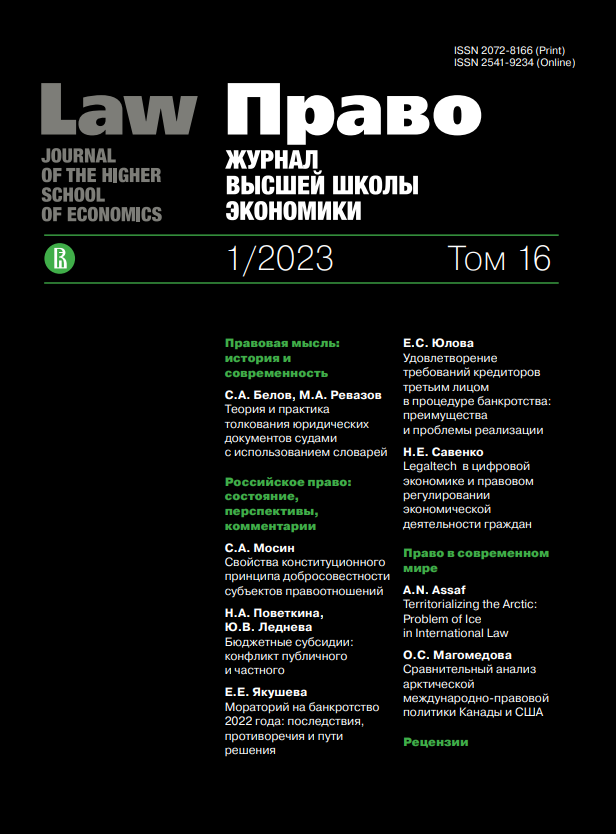Territorializing the Arctic: Problem of Ice in International Law
Abstract
Following the 2021 Suez Canal obstruction, humanity is now in search of safer and better functioning maritime trade routes, and the icy Arctic turns out to be one of the key candidates. The article contributes to the current debate concerning the status of ice in International Law, the legal status of which remains unclear, stuck in a limbo between the law of the terrain and the law of the sea. The methodology includes reconfiguring the meaning of ‘territory’ under International Law through conducting an evolutionary interpretation to provide grounds for the existence of a ratione materiae type of territory, supported by related domestic and international legal instruments of Alpine and Arctic States. The article outlines useful elements from similar experiments on the measurement of ice features employed in the process of the Alps border demarcation and administration. In conclusion, a sketch of a ‘functional’ Arctic is drawn to suit a world aiming at a sustainable human-nature relationship. The paper aims to introduce ‘ice’ as a legally valid criterion under the law of territory that can be applied in sovereignty disputes on a regular rather than sui generis basis. It demonstrates the fallacy of the static conception of territory in the modern day, particularly when applied in a dynamic environment such as the Arctic, while also stressing the importance of multidisciplinary learning and its critical role in advancing legal theory in domains considered to be the most normatively rigid, such as territorial sovereignty.
References
Agnew J. (2017) Globalization and sovereignty: beyond territorial trap. Totowa (N.J.): Rowman & Littlefield, 240 p.
Baker B., Mooney S. (2013) The legal status of Arctic sea ice in the United States and Canada. Polar Geography, vol. 36, no. 1-2, pp. 86-104. DOI: https://doi.org/10.1080/1088937X.2012.705914
Berkman P., Vylegzhanin A., Young O. (2019) Baseline of Russian Arctic laws. Cham: Springer International, 744 p. DOI: https://doi.org/10.1007/978-3-030-06262-0
Bílková V. (2017) A State without territory? Netherlands Yearbook of International Law 2016: The Changing Nature of Territoriality in International Law. Berlin: Springer, pp. 1-2. DOI: https://doi.org/10.1007/978-94-6265-207-1_2
Boyd S. (1985) The legal status of the Arctic Sea ice: a comparative study and a proposal. Canadian Yearbook of International Law, vol. 22, pp. 98-152.
Branch J. (2015) The cartographic state: maps, territory and the origins of sovereignty. Cambridge: University Press, 241 p.
Bruun J., Steinberg P. (2018) Placing territory on ice: militarisation, measurement and murder in the high Arctic. In: Territory beyond terra. K. Peters, P. Steinberg, E. Stratford (eds.). Totowa (N.J.): Rowman Littlefield, 352 p.
Buixadé F. et al. (2014) Commercial Arctic shipping through the Northeast Passage: routes, resources, governance, technology, and infrastructure. Polar Geography, vol. 37, no. 4, pp. 298-324. DOI: https://doi.org/10.1080/1088937X.2014.965769
Cavell J. (2019) The sector theory and the Canadian Arctic, 1897-1970. The International History Review, vol. 41, no. 6, pp. 1168-1193. DOI: https://doi.org/10.1080/07075332.2018.1475404
Conforti B. (1993) International law and the role of domestic legal systems. Leiden: Nijhoff, 224 p. DOI: https://doi.org/10.1163/9789004637948
Conforti B. (1995) The Theory of Competence in Verdross. European Journal of International Law, vol. 6, no. 1, pp. 70-77. DOI: https://doi.org/10.1093/ejil/6.1.70
Crawford J. (2007) The creation of states in international law. Oxford: University Press, 943 p. DOI: https://doi.org/10.1093/acprof:oso/9780199228423.001.0001
Dodds K. (2021) Border Wars: The Conflicts of Tomorrow. N.Y.: Random House, 257 p.
Dodds K., Nuttall M. (2016) The scramble for the poles: the geopolitics of the Arctic and Antarctic. N.Y.: Wiley, 200 p.
Donaldson J., Williams A. (2008) Delimitation and demarcation: analysing the legacy of Stephen B. Jones's boundary-making. Geopolitics, vol. 13, no. 4, pp. 676-700. DOI: https://doi.org/10.1080/14650040802275503
Döscher R., Vihma T., Maksimovich E. (2014) Recent advances in understanding the Arctic climate system state and change from a sea ice perspective: a review. Atmospheric Chemistry and Physics, vol. 14, no. 24, pp. 13571-13600. DOI: https://doi.org/10.5194/acp-14-13571-2014
Elden S. (2017) Legal terrain — the political materiality of territory. London Review of International Law, vol. 5, no. 2, pp. 199-224. DOI: https://doi.org/10.1093/lril/lrx008
Forbes B. et al. (2016) Sea ice, rain-on-snow and tundra reindeer nomadism in Arctic Russia. Biology Letters, vol. 12, no. 11, p. 466. DOI: https://doi.org/10.1098/rsbl.2016.0466
Gearheard S., Huntington H., Holm L. (2013) The meaning of ice: people and sea ice in three Arctic communities. Berlin: International Polar Institute Press, 366 p.
Geon B. (1997) A right to ice? The application of international and national Water laws to the acquisition of iceberg rights. Michigan Journal of International Law, vol. 9, no. 1, pp. 277-301.
Gottmann J. (1973) The significance of territory. Charlottesville: Virginia University Press, 200 p.
Heuer C. (2019) Into the white: The renaissance Arctic and the end of the image. Cambridge (Mass.): MIT Press, 262 p. DOI: https://doi.org/10.2307/j.ctv14gpj8q
Johns F. (2017) Data territories: changing architectures of association in international law. Netherlands Yearbook of International Law 2016: The Changing Nature of Territoriality in International Law. Dordrecht: Springer, 524 p. DOI: https://doi.org/10.1007/978-94-6265-207-1_5
Joyner C. (1991) Ice-covered regions in international law. The International Law of the Hydrologic Cycle, vol. 31, no. 1, pp. 213-242.
Kaiser B., Pahl J. (2018) Arctic port development, Arctic marine resource governance and development. Berlin: Springer, 235 p.
Kelsen H. (2007) General Theory of Law and State. New Brunswick (N.J.): Transaction Publishers, 516 p.
Kirchner S. (2020) Cross-border forms of animal use by indigenous peoples. Studies in global animal law. Berlin: Springer, 183 p. DOI: https://doi.org/10.1007/978-3-662-60756-5_6
Kohen M., Hébié M. (2018) Territorial conflicts and their international legal framework. Research Handbook on Territorial Disputes in International Law. Cheltenham: Edward Elgar, 520 p. DOI: https://doi.org/10.4337/9781782546870.00008
Koivurova T, Kankaanpää P, Stşpieή A. (2015) Innovative environmental protection: lessons from the Arctic. Journal of Environmental Law, vol. 27, no. 2, pp. 285311. DOI: https://doi.org/10.1093/jel/equ037
Lakhtine W. (1930) Rights over the Arctic. The American Journal of International Law, vol. 24, no. 4, pp. 703-717. DOI: https://doi.org/10.2307/2190058
Marchetti P. (2004) Giuristi e i confini. L'elaborazione giuridica della nozione di confine tra medioevo ed età moderna, Immagini d'Italia e d'Europa nella letteratura e nella documentazione di viaggio nel XVIII e nel XIX secolo Atti. Florence: Firenze University Press, 186 p.
Milano E. (2006) Unlawful Territorial Situations in International law: Reconciling Effectiveness, Legality and Legitimacy. Leiden: Nijhoff, pp. 69-70. DOI: https://doi.org/10.1163/ej.9789004149397.i-308
O'Connell D., Shearer I. (1982) The International Law of the Sea: Vol. I. Oxford: University Press, 634 p.
Oppenheim L. (1955) International Law: A Treatise. N.Y.: Longmans, 1072 p.
Pharand D. (1988) Canada's Arctic Waters in International Law. Cambridge: University Press, 289 p. DOI: https://doi.org/10.1017/CBO9780511565458
Prescott V., Triggs G. (2008) International Frontiers and Boundaries: Law, Politics and Geography. Leiden: Brill, 504 p. DOI: https://doi.org/10.1163/ej.9789004167858.i-504
Rayfuse R. (2018) Russian Flag at the North Pole. International Law's Objects. Oxford: University Press, 568 p. DOI: https://doi.org/10.1093/oso/9780198798200.003.0035
Rothwell D. (2013) The Law of the Sea and Arctic Governance, Proceedings of the Annual Meeting. American Society of International Law, vol. 107, pp. 272-275. DOI: https://doi.org/10.5305/procannmeetasil.107.0272
Schmitt C. (2008) Constitutional Theory. Durham: Duke University Press, 488 p.
Schwarzenberger G. (1957) International Law as Applied by International Courts and Tribunals. London: Stevens, 681 p.
Shaw M. (1982) Territory in International Law. Netherlands Yearbook of International Law, pp. 61-91. DOI: https://doi.org/10.1017/S0167676800003019
Shaw M. (1997) The Heritage of States: The Principle of Uti Possidetis Juris Today. British Yearbook of International Law, vol. 67, no. 1, pp. 75-154. DOI: https://doi.org/10.1093/bybil/67.1.75
Solski J. (2021) The Genesis of Article 234 of the UNCLOS. Ocean Development and International Law, vol. 51, no. 1, pp. 1-19. DOI: https://doi.org/10.1080/00908320.2020.1835026
Starke J. (1968) The Acquisition of Territorial Sovereignty by Newly Emerged States. The Australian Yearbook of International Law, vol. 2., no. 1, pp. 9-15. DOI: https://doi.org/10.1163/26660229-002-01-900000003
Tanaka Y. (2019) The International Law of the Sea. Cambridge: Cambridge University Press, 584 p.
Valková I. (2017) Claiming the Arctic: legal geography of the northernmost sovereignty dispute. The Polar Journal, vol. 7, no. 1, pp. 143-164. DOI: https://doi.org/10.1080/2154896X.2017.1310489
Varzi A. (2016) On drawing lines across the board. In: The theory and practice of ontology. L. Zaibert (ed.). London: Palgrave Macmillan, 301 p. DOI: https://doi.org/10.1057/978-1-137-55278-5_4
Vaughan R. (1982) The Arctic in the Middle Ages. Journal of Medieval History, vol. 8, no. 4, pp. 313-342. DOI: https://doi.org/10.1016/0304-4181(82)90014-8
Verdross A. (1962) Die Verfassung der Völkerrechtsgemeinschaft. Wien: Springer, 230 p.
Verdross A. (1955) Völkerrecht. Wien: Springer, 508 p. DOI: https://doi.org/10.1007/978-3-7091-3596-9
Verzijl J. (1970) International Law in Historical Perspective. Vol. 3. Leiden: Brill, 634 p.
Vylegzhanin A. et al. (2010) Navigation in the Northern Sea route: interaction of Russian and international applicable law. The Polar Journal, vol. 10, no. 2, pp. 285-302. DOI: https://doi.org/10.1080/2154896X.2020.1844404
Wilkes D. (1972) Law for special environments: ice islands and questions raised by the T-3 case. Polar Record, vol. 16, pp. 23-27. DOI: https://doi.org/10.1017/S0032247400062392
Copyright (c) 2023 Law Journal of the Higher School of Economics

This work is licensed under a Creative Commons Attribution-ShareAlike 4.0 International License.


















